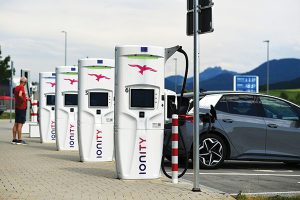Bloomberg
Europe will have 130 million electric vehicles (EVs) on the road by 2035, according to a joint report from Ernst & Young and the electricity industry trade association Eurelectric.
The report’s projections show Europe’s EV fleet growing from its current base of less than 5 million to 65 million by 2030 and then doubling over the following five years. EY estimates that the continent will need 65 million chargers to fuel these cars, trucks, and buses, with 85% of plugs installed at homes:
Europe’s rapid adoption of electric vehicles presents two large tasks for utility providers. The first is to build a network of 9 million out-of-home chargers along roadways, at workplaces, and at fleet-charging hubs. There are about 445,000 public connectors installed across Europe, according to the latest tally from BloombergNEF.
“It took us 10 years to install 400,000 chargers,†says Serge Colle, EY’s global energy and resources leader. “Now we’ll need to do about 500,000 every single year until 2030 and about 1 million every year between 2030 and 2035.†EY estimates that tab for this buildout will be $62 billion, with another $72 billion needed to install the 56 million
residential chargers.
The ramp-up of electric cars will coincide with an increase in renewable energy generation, the electrification of heating and an increase in extreme weather. “It’s just absolutely critical that we don’t sit on our hands and wait,†says Kristian Ruby, secretary general of Eurelectric.
 The Gulf Time Newspaper One of the finest business newspapers in the UAE brought to you by our professional writers and editors.
The Gulf Time Newspaper One of the finest business newspapers in the UAE brought to you by our professional writers and editors.
